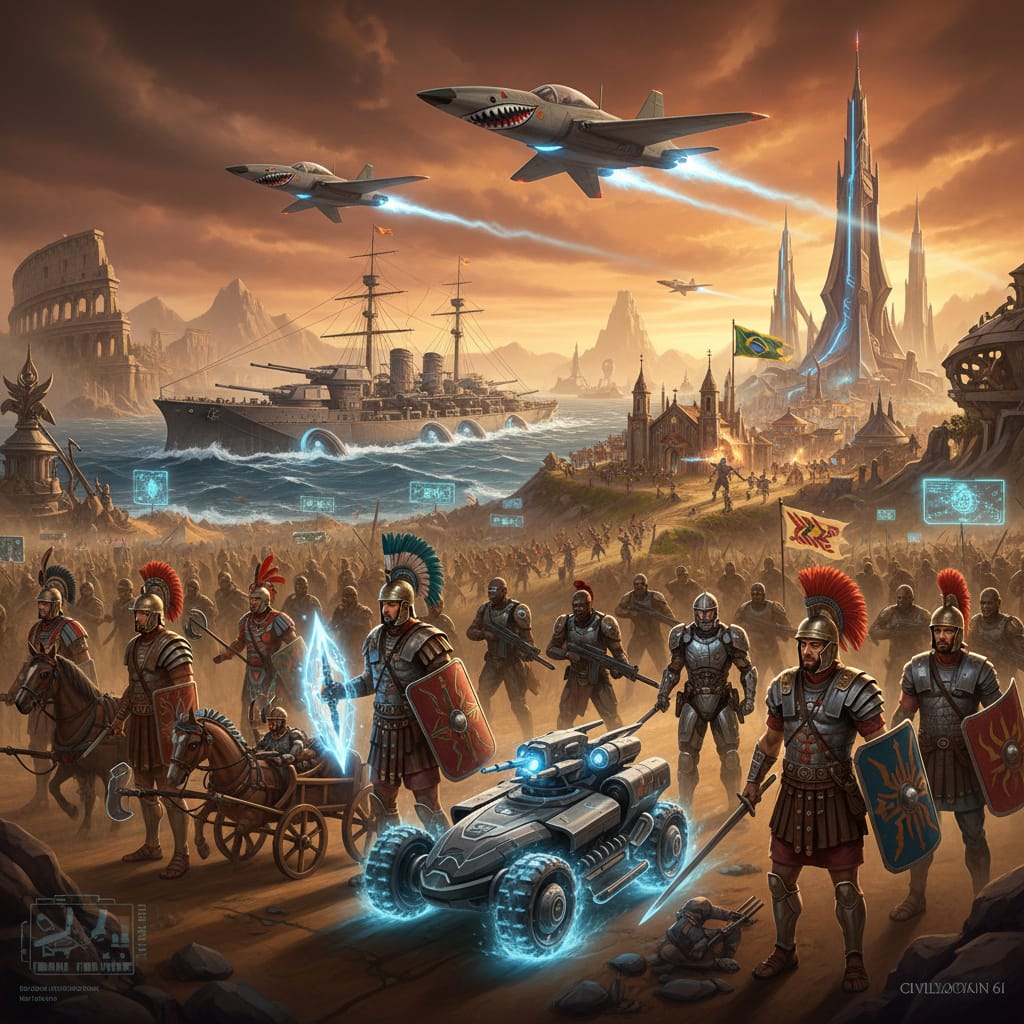In the grand strategy of Civilization 6, the march of time is relentless. Technologies advance, new eras dawn, and the powerful armies of one generation become the museum pieces of the next. Unique Units, the special pride of each civilization, are often the sharpest spear in a player’s arsenal, but their time in the sun is fleeting. But what if this fundamental rule of obsolescence was broken? Imagine a world where every Unique Unit (UU) not only remained a viable choice for production throughout the entire game but also upgraded into its modern equivalent for free, retaining its distinct advantages. This single change would not merely alter the game; it would shatter the established meta, creating a cascade of strategic consequences that would redefine the very nature of power, warfare, and civilization identity.
The player community has long debated the fleeting relevance of UUs. Forum discussions frequently lament the short-lived glory of units like the Roman Legion or the Aztec Eagle Warrior. While mods exist to prolong their existence, the concept of permanent, freely upgrading UUs presents a radical strategic paradigm. This analysis delves into the profound, game-altering implications of such a scenario, exploring which civilizations would rise to god-tier status and how the art of war would be irrevocably transformed.
The Unending Onslaught: Early Game Aggressors Become Eternal Juggernauts
The most immediate and seismic shift would be the permanent relevance of ancient and classical era UUs. In the standard game, these units offer a critical, but temporary, window of opportunity. In this new reality, that window never closes.
Rome: The Indomitable Legions
Analysis on forums shows that Rome is already a top-tier civilization, but with eternally relevant Legions, it would become a military titan of unparalleled consistency. The Legion isn’t just a stronger Swordsman; it’s a corps of military engineers.
- Perpetual Expansion and Fortification: Legions could be produced from the Classical Era to the Information Era. This means a constant supply of units that can instantly build a Fort. Imagine late-game Roman armies, composed of Mechanized Infantry Legions, carving out defensive positions deep in enemy territory, creating an unstoppable forward-operating base. The ability to drop a Fort, providing +4 Combat Strength and entrenchment, would make Roman armies incredibly resilient.
- Economic Powerhouse: Each Legion comes with a free build charge. In the early game, this is a nice bonus. Spread across an entire game, it becomes an economic juggernaut. Legions could be produced en masse not just for war, but as a form of economic stimulus, constantly improving tiles and building districts.
The Aztec Eagle Rush: A Never-Ending Tide of Warriors
The Aztec Eagle Warrior is a terror in the early game. Its ability to capture enemy units and turn them into Builders is the engine of the Aztec’s snowball potential. Now, picture that engine running for 6,000 years.
- An Economy Built on War: With Eagle Warriors never becoming obsolete, every war, at any point in history, would directly fuel the Aztec economy. Capturing a modern army would mean a sudden influx of dozens of Builders, leading to explosive infrastructure growth. The Aztecs would be incentivized to wage perpetual war simply to feed their ever-expanding empire.
- The Ultimate Swarm: Eagle Warriors are cheap and effective. With free upgrades, an early-game swarm of Eagle Warriors would seamlessly transition into a modern horde of Eagle Warrior Mechanized Infantry, retaining their capture ability. The strategic calculus for fighting the Aztecs would be terrifying: any unit you lose becomes their gain.
Sumeria’s War-Cart: The Unstoppable Chariot
Many professional gamers suggest that the Sumerian War-Cart is the most powerful unit in the early game. It’s fast, strong, and suffers no penalties against anti-cavalry units. With perpetual relevance, Sumeria would be a constant menace.
- The Blitzkrieg Perfected: A wave of War-Carts could dominate the early game, and that wave would never need to stop. Upgrading for free into Knights, Cavalry, and then Tanks, the core of the Sumerian army would always be a fast, hard-hitting force that ignores traditional counters. A popular strategy would be to maintain a massive standing army of these upgraded War-Carts, ready to strike at a moment’s notice.
The Mid-Game Power Spike Becomes a Permanent Plateau
The mid-game is often where civilizations with powerful unique units can turn the tide. In this hypothetical scenario, that turning point becomes a permanent state of being.
The Zulu Impi: A Legion of Elite Soldiers
The Zulu Impi is a game-changer. Cheaper to produce, with a lower maintenance cost and a devastating flanking bonus, an Impi corps can overwhelm even technologically superior foes.
- The Unbreakable Core: With Impis never becoming obsolete, the Zulu could field a massive, professional army for the entire game. The reduced production cost and maintenance would mean a larger standing army than any other civilization could afford.
- An Army of Veterans: Impis gain experience faster. In a world of free upgrades, this means a Zulu army would be perpetually composed of highly promoted, elite units. An Impi corps from the Medieval era could, over centuries of combat and free upgrades, become a force of Information Era super-soldiers, bristling with promotions.
The Spanish Conquistador: A Religious Crusade Across Millennia
The Spanish Conquistador is a unique blend of military and religious might. It’s stronger than a Musketman and automatically converts a captured city to Spain’s religion.
- The Eternal Inquisition: With Conquistadors available in every era, Spain’s military expansion would be synonymous with religious conversion. Every city captured, from the Renaissance to the modern day, would instantly join the Spanish faith. This would make a Religious Victory through military means a terrifyingly viable strategy. The Conquistador’s +10 Combat Strength bonus when stacked with a religious unit would remain a potent threat on any battlefield.
The Persian Immortal: The Ultimate Hybrid Warrior
The Persian Immortal is a swordsman with a ranged attack. This simple difference makes it one of the most versatile units in the game.
- A Flexible Fighting Force: An army of Immortals, upgrading through the eras, would be a nightmare to counter. They could bombard enemies from a distance before closing for the kill, effectively acting as their own fire support. This flexibility would make them incredibly efficient in both offense and defense, a self-sufficient fighting force that would dominate the battlefield.
The Redefinition of Late-Game Warfare
The late game, often a clash of generic, powerful units, would be completely upended. Civilizations with strong UUs would bring their unique flavor to the final showdown.
Brazil’s Minas Geraes: Ruling the Waves from the Industrial Era Onward
The Minas Geraes is a Battleship that arrives an era early. This is already a massive advantage. In our scenario, it becomes the cornerstone of Brazilian naval supremacy for the rest of the game.
- Unchallenged Naval Hegemony: Brazil could begin producing these super-battleships in the Industrial Era and never stop. By the time other civilizations are launching their first crude ironclads, Brazil would already have a fleet of advanced warships. This naval dominance would be absolute and unbreakable, allowing Brazil to control the seas, project power globally, and launch devastating coastal assaults with impunity.
America’s P-51 Mustang: Owning the Skies
The P-51 Mustang is a superior fighter plane, earning experience faster and dominating the skies. With perpetual relevance, America’s air force would be second to none.
- A Legacy of Air Superiority: America could build a core of P-51s that would upgrade into Jet Fighters and then into Information Era air superiority fighters, all while retaining their bonus experience gain. This would result in an air force of legendary aces, capable of sweeping the skies of any opposition and providing decisive air support in any conflict.
New Strategic Realities and a New World Order
The implications of this change go beyond individual civilizations. The very fabric of strategic decision-making would be altered.
The End of “Timing Pushes”
A popular strategy in Civilization 6 is the “timing push,” an attack designed to leverage a temporary technological advantage, often centered around a UU. With UUs never becoming obsolete, this concept would vanish. A civilization’s unique strength would no longer be a fleeting moment to be exploited, but a permanent feature of their identity.
The Rise of “UU Stacking”
Army composition would become far more diverse and interesting. A popular strategy would be to combine the unique abilities of different UUs. Imagine a Roman Legion creating a fort, then a Persian Immortal garrisoning it, using its ranged attack to fend off attackers. Or a Zulu Impi corps screening a line of English Redcoats, the combination of flanking bonuses and defensive firepower creating an unbreakable line.
Economic and Production Revolutions
The “free upgrades” clause is a quiet revolution in itself.
- The End of Upgrade Costs: The massive gold expenditure required to upgrade an army would simply disappear for UUs. This would free up enormous amounts of gold for other purposes, such as infrastructure development, diplomacy, or funding a larger standing army.
- Production Focus: Production would be geared towards creating a core of UUs early in the game, knowing that this investment would pay dividends for thousands of years. The decision to build a UU would no longer be a short-term tactical choice, but a long-term strategic investment.
A New Pantheon of Power
In a world where Unique Units never fade and upgrade for free, the balance of power in Civilization 6 would be irrevocably shattered. The game would become a clash of titans, each wielding their unique, eternal strengths. Early-game aggressors like Rome, the Aztecs, and Sumeria would become relentless juggernauts, their power growing with each passing era. Mid-game powerhouses like the Zulu and Spain would establish a permanent plateau of military and religious dominance. The late game would be a spectacular showdown of unique, powerful forces, from Brazil’s unsinkable armada to America’s ace pilots.
This hypothetical scenario transforms Unique Units from a temporary advantage into the very soul of a civilization’s military identity. The art of war would become a grander, more epic affair, a 6,000-year-long chess match where the special pieces never leave the board. The player community’s dream of eternally relevant Unique Units would create a more dynamic, more asymmetrical, and ultimately, a more interesting game. The familiar march of progress would still exist, but it would be a march led by the immortal legions, the unending swarms, and the unbreakable corps of history’s most legendary warriors.


